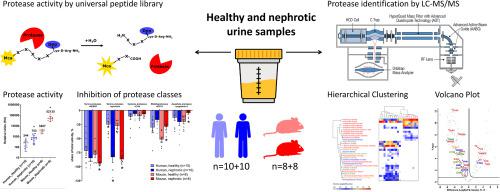Journal of Proteomics ( IF 3.3 ) Pub Date : 2020-09-12 , DOI: 10.1016/j.jprot.2020.103981 Matthias Wörn 1 , Bernhard N Bohnert 2 , Fawza Alenazi 1 , Karsten Boldt 3 , Franziska Klose 3 , Katrin Junger 3 , Marius Ueffing 3 , Andreas L Birkenfeld 2 , Hubert Kalbacher 4 , Ferruh Artunc 2

|
Nephrotic syndrome is characterized by urinary excretion of plasma proteases or proteasuria. There is a lack of data on the quantity, activity status and identity of these aberrantly filtered proteases.
We established a fluorescence-based substrate assay to quantify protease activity in urine samples from healthy and nephrotic humans and mice. Protease class activity was determined after addition of specific inhibitors. Individual proteases were identified by tandem mass spectrometry (MS/MS).
In spot urine samples from 10 patients with acute nephrotic syndrome of various etiology, urinary protease activity was significantly increased compared to that of healthy persons (753 ± 178 vs. 244 ± 65 relative units, p < 0.05). The corresponding proteases were highly sensitive to inhibition by the serine protease inhibitors AEBSF (reduction by 85 ± 6% and 72 ± 8%, respectively) and aprotinin (83 ± 9% vs. 25 ± 6%, p < 0.05). MS/MS of all urinary proteins or after AEBSF purification showed that most of them were active serine proteases from the coagulation and complement cascade. These findings were recapitulated in mice, pointing to a similar pathophysiology.
In conclusion, nephrotic syndrome leads to increased urinary excretion of active plasma proteases which can be termed proteasuria. Serine proteases account for the vast majority of urinary protease activity in health and nephrotic syndrome.
Significance statement
In this study, we found that nephrotic urine samples of humans and mice have a significantly increased protease activity compared to healthy urine samples, using a universal pentapeptide substrate library. This was driven by increased excretion of aprotinin-sensitive serine proteases. With tandem mass spectrometry, we provide a comprehensive and systematic overview of all urinary proteases or the “urine proteasome”. We identified renally expressed proteases in health and addition of proteases from the coagulation and complement cascade in the nephrotic state. These results set the basis to study the role of urinary proteases at both health and nephrotic syndrome to find diagnostic markers of renal disease as well as possible therapeutic targets.
中文翻译:

肾病综合征中的蛋白尿定量和蛋白质组分析。
肾病综合症的特征是尿液中血浆蛋白酶或蛋白酶尿的排泄。缺乏关于这些异常过滤的蛋白酶的数量,活性状态和特性的数据。
我们建立了基于荧光的底物测定法,以定量来自健康和肾病性人类和小鼠的尿液样品中的蛋白酶活性。加入特异性抑制剂后确定蛋白酶类别的活性。通过串联质谱法(MS / MS)鉴定了单个蛋白酶。
在10位各种病因的急性肾病综合症患者的尿液样本中,尿蛋白酶活性与健康人相比明显增加(753±178对244±65相对单位,p <0.05)。相应的蛋白酶对丝氨酸蛋白酶抑制剂AEBSF(分别降低85±6%和72±8%)和抑酶肽的抑制作用高度敏感(83±9%对25±6%,p <0.05)。所有尿蛋白或AEBSF纯化后的MS / MS结果表明,大多数尿蛋白是来自凝血和补体级联反应的活性丝氨酸蛋白酶。在小鼠中概括了这些发现,指出了类似的病理生理。
总之,肾病综合征导致活性血浆蛋白酶的尿排泄增加,这可以称为蛋白酶尿症。在健康和肾病综合症中,丝氨酸蛋白酶占尿蛋白酶活性的绝大部分。
重要性声明
在这项研究中,我们发现,使用通用五肽底物库,与健康尿液样品相比,人和小鼠的肾病尿液样品的蛋白酶活性显着增加。这是由于抑肽酶敏感的丝氨酸蛋白酶排泄增加所致。通过串联质谱,我们提供了所有尿蛋白酶或“尿蛋白酶体”的全面而系统的概述。我们确定了健康状态下肾脏表达的蛋白酶,并从肾病状态下的凝血和补体级联中添加了蛋白酶。这些结果为研究尿蛋白酶在健康和肾病综合征中的作用奠定了基础,以发现肾脏疾病的诊断标记以及可能的治疗靶标。



























 京公网安备 11010802027423号
京公网安备 11010802027423号